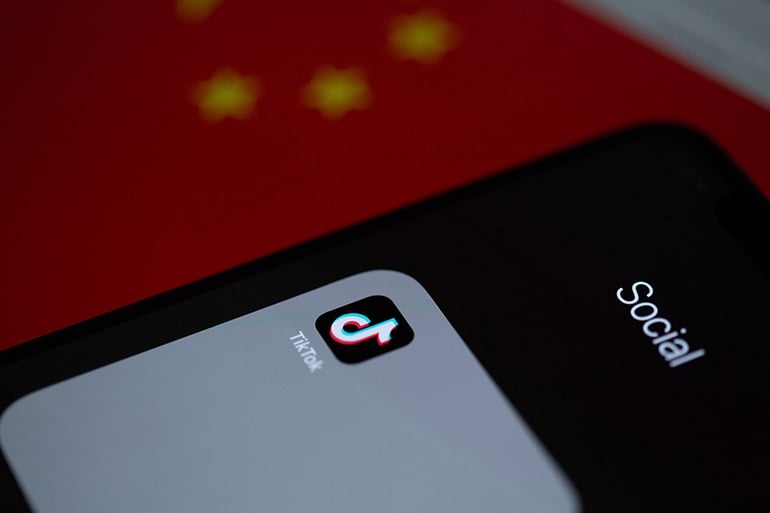
With social distancing measures and restrictions on in-person gatherings in place in the United States as a result of the COVID-19 pandemic, the use of social media has surged by Americans in an effort to stay connected and combat the isolation that is inevitable given the current circumstances. TikTok, a relatively new social media platform to emerge, has garnered a steep increase in users in recent months. The number of downloads has totaled over 1.3 billion worldwide, with more than 120 million in the U.S. alone.
TikTok is a social media app that is used to create and share short, 15-second videos of dancing, lip-synching or other forms of self-expression. It also has the capacity to allow users to post short looping videos between three and 60 seconds in length. The app sets itself apart by offering a wide array of music, animation, special effects and filters that users can apply to their videos. Similar to other social media apps like Facebook and Instagram, TikTok users can follow each other and “like” others’ posts.
Notably, during the shutdown TikTok has provided entertainment and an “escape” to those in under stay-at-home orders. However, recent lawsuits have brought to light privacy issues that exist within the seemingly harmless social media app. On August 4, 2020, the Judicial Panel for Multidistrict Litigation consolidated 10 litigations that challenge the app’s conduct with respect to the scanning, capture, retention and dissemination of the facial geometry and other biometric information of its users into a multidistrict litigation in the Northern District of Illinois under Judge John Z. Lee.
However, according to plaintiffs currently engaged in suits against the TikTok and its China-based parent company ByteDance Inc., the perceived playful and light-hearted reputation belies the fact that the app relies on users’ private, biometric information. The suit states that TikTok scans a user’s facial geometry before running an algorithm to determine the user’s age. The app also employs facial scans to allow users to superimpose animated facial filters onto the moving faces of subjects in a video.
Plaintiffs argue that the app fails to inform users that their biometric data is being collected, captured, received, obtained, stored and/or used by the app. Further, the plaintiffs argue that the app fails to disclose how TikTok Inc. and its parent company use the data received, how long the data is stored and who has the ability to access the data.
Some of the claims assert that TikTok is taking advantage of the unsophistication of its youthful followers by targeting minor children and misleading them into disclosing personal identifying information without parental consent. It is widely acknowledged that TikTok’s primary audience is young people, with 60% of active users being between the ages of 16 and 24. In addition, according to court documents, around 70% of ten-year-old girls who have access to or own smartphones were reported to have used TikTok at some point in 2019. According to reports from both the Google App Store and Apple’s iTunes Store, TikTok is the most downloaded non-gaming app in the world—surpassing Facebook, Snapchat and Instagram.
What many TikTok users fail to understand is how valuable biometric data truly is. Biometrics are unlike any other unique identifier and are used as a verification of identity. This is turn can be used to access a wide range of sensitive personal information, from financial information to private health information. As one lawsuit against the app explained, biometric data is unique in that it cannot be replaced or changed in a manner similar to when other personal information is compromised, such as a social security number or credit card information. In the instance that an individual’s biometric data is compromised or hacked, the individual has no real recourse and is therefore at a heightened risk for identity theft.
As outlined in the complaints, TikTok’s terms of use and privacy policy are notably vague and fail to inform users of the extent to which their personal biometric information is collected. Accordingly, the app’s most recent U.S. Terms of Service, updated in February 2019, failed to mention crucial words like ‘biometric,’ ‘facial,’ ‘recognition,’ ‘face,’ ‘scan,’ ‘faceprint,’ ‘geometry’ or ‘landmark.’ However, it is important to note that as recently as 2018, the TikTok U.S. privacy policy did indicate that users’ information would be shared with any member or affiliate of its company in China.
The newly consolidated multidistrict litigation focused on the app’s use of users’ information is not the first time that TikTok has faced claims of violating users’ privacy. In 2019, the Federal Trade Commission (“FTC”) reached a $5.7 million settlement with the app after alleging that TikTok violated the Children’s Online Privacy Protection Act, by knowingly allowing users under the age of 13 to use the app without parental consent and subsequently collecting their data. The claims brought by FTC pointed to the fact that users often list their actual ages in short bios on the app, thereby putting TikTok on notice of the age of users. The company agreed at the time of the settlement, to require age verification for users, however recent government investigations have shown that the app may not have lived up to the terms of the settlement.
Litigations in the MDL against TikTok are in the very early stages. Given the large number of individuals who use the app regularly, it may follow that there could be a significant increase in case filings in the coming months.
The case is: In Re: TikTok, Inc., Consumer Privacy Litigation, MDL No.: 2948





